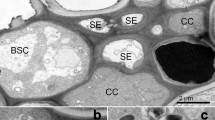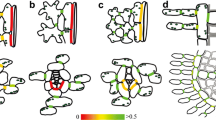Abstract
Plant species which translocate distinct combinations of carbohydrates in the phloem were investigated to assess whether differences in minor-vein anatomy were associated with differences in carbohydrate composition of the phloem sap. In Vicia faba L., a species in which the minor-vein companion cells are modified into transfer cells, sucrose alone was found to be the translocated form of carbohydrate. In Vicia, phloem transport of sucrose was inhibited by pretreatment of leaves with p-chloromercuribenzenesulfonic acid (PCMBS), a known inhibitor of the sucrose carrier. In contrast, in Ocimum basilicum L., a species in which the minor-vein companion cells are of the symplasmically linked intermediary cell type, both sucrose- and raffinose-family oligosaccharides were exported in the phloem. In this species, no PCMBS sensitivity was observed for phloem transport of either sucrose- or raffinose-family oligosaccharides, although a PCMBS-sensitive sucrose carrier was detected in leaf tissues. This carrier did not appear to be involved in phloem loading, rather, it appeared that phloem loading occurred via the symplasm in this species. In the polyoltranslocating species Petroselinum crispum L., the same insensitivity to PCMBS was seen, suggesting that symplasmic phloem loading also occurred. The companion cells were symplasmically connected to the surrounding bundle-sheath cells by numerous “H”-shaped plasmodesmata but were not intermediary cells, and no raffinose oligosaccharides were exported by Petroselinum. Taken together, the data indicate that apoplasmic transport may be responsible for phloem loading in species in which sucrose alone is exported. However, in those plant species in which a combination of sucrose and any other carbohydrate, including the polyols, is translocated, symplasmic phloem loading may predominate.
Similar content being viewed by others
Abbreviations
- PCMBS:
-
p-chloromercuribenzenesulfonic acid
References
Beebe DU, Turgeon R (1992) Localization of galactinol, raffinose and stachyose synthesis in Cucubita pepo leaves. Planta 188: 354–361
Bourquin S, Bonnemain JL, Delrot S (1990) Inhibition of loading of 14C-assimilates by p-chloromercuri-benzenesulfonic acid. Localization of the apoplasmic pathway in Vicia faba. Plant Physiol 92: 97–102
Everard JD, Franceschi VR, Loescher WH (1993) Mannose-6-phosphate reductase, a key enzyme in photoassimilate partitioning, is abundant and located in the cytosol of photosynthetically active cells of celery (Apium graveolens L.) source leaves. Plant Physiol 102: 345–356
Fisher DG (1986) Ultrastructure, plasmodesmatal frequency and solute concentration in green areas of variegated Coleus blumei Benth. leaves. Planta 169: 141–152
Flora LL, Madore MA (1993) Sucrose and mannitol transport in olive (Olea europaea L.). Planta 189: 484–490
Gamalei YV (1985) Characteristics of phloem loading in woody and herbacious plants. Fiziol Rast 32: 866–875
Gamalei YV (1989) Structure and function of leaf minor veins in trees and herbs: a taxonomic review. Trees 3: 96–110
Gamalei YV (1991) Phloem loading and its development related to plant evolution from trees to herbs. Trees 5: 50–64
Giaquinta RT (1976) Evidence for phloem loading from the apoplasm. Chemical modification of membrane sulfhydryl groups. Plant Physiol 57: 872–875
Gunning BES, Pate JS (1969) “Transfer cells”. Plant cells with wall ingrowths, specialized in relation to short distance transport of solutes. Their occurrence, structure, and development. Protoplasma 68: 107–133
Holthaus U, Schmitz K (1991) Distribution of stachyose synthase in Cucumis melo L. Planta 185: 479–486
Kandler O (1967) Biosynthesis of poly- and oligosaccharides during photosynthesis in green plants. In: Pietro A, Greer FA, Army TJ (eds) Harvesting the sun: photosynthesis and plant life. San Academic Press, New York, pp 131–152
Karnovsky MJ (1965) A formaldehyde-glutaraldehyde fixative of high osmolarity for use in electron microscopy. J Cell Biol 27: 137A-138A
King RW, Zeevaart JAD (1974) Enhancement of phloem exudation from cut petioles by chelating agents. Plant Physiol 53: 96–103
Loescher WH (1987) Physiology and metabolism of sugar alcohols in higher plants. Physiol Plant 70: 553–557
Loescher WH, Tyson RH, Everard JD, Redgwell RJ, Bieleski RL (1992) Mannitol synthesis in higher plants. Plant Physiol 98: 1396–1402
Madore MA (1990) Carbohydrate metabolism in photosynthetic and nonphotosynthetic tissues of variegated leaves of Coleus blumei Benth. Plant Physiol 93: 617–622
Madore MA, Mitchell DE, Boyd CM (1988) Stachyose synthesis in source leaf tissues of the CAM plant Xerosicyos danguyi H. Humb. Plant Physiol 87: 588–591
M'Batchi B, Delrot S (1984) Parachloromercuri-benzenesulfonic acid. A potential tool for differential labeling of the sucrose transporter. Plant Physiol 70: 1436–1443
Mitchell DE, Gadus MV, Madore MA (1992) Patterns of assimilate production and translocation in muskmelon (Cucumis melo L.) I. Diurnal patterns. Plant Physiol 99: 959–965
Oparka KJ, Prior DAM (1992) Direct evidence for pressure-generated closure of plasmodesmata. Plant J 2: 741–750
Riesesmeier JW, Hirner B, Frommer WB (1993) Potato sucrose transporter expression in minor veins indicates a role in phloem loading. Plant Cell 5: 1591–1598
Riesemeier JW, Willmitzer L, Frommer WB (1994) Evidence for an essential role of the sucrose transporter in phloem loading and assimilate partitioning. EMBO J 13: 1–7
Schmitz K, Cuypers B, Moll M (1987) Pathways and assimilate transfer between mesophyll cells and minor veins in leaves of Cucumis melo L. Planta 171: 19–29
Spurr AR (1969) A low-viscosity epoxy resin embedding medium for electron microscopy. J Ultrastruct Res 26: 31–43
Turgeon R (1991) Symplasmic phloem loading and the sink-source transition in leaves: a model. In: Bonnemain J-L, Delrot S, Lucas WJ, Dainty J (eds) Recent advances in phloem transport and assimilate compartmentalion. Ouest Editions, Nantes, France, pp 18–22
Turgeon R, Beebe DU (1991) The evidence for symplasmic phloem loading. Plant Physiol 96: 349–354
Turgeon R, Gowan E (1990) Phloem loading in Coleus blumei in the absence of carrier-mediated uptake of export sugar from the apoplast Plant Physiol 94: 1244–1249
Turgeon R, Gowan E (1992) Sugar synthesis and phloem loading in Coleus blumei leaves. Planta 187: 388–394
Turgeon R, Beebe DU, Gowan E (1993) The intermediary cell: Minorvein anatomy and raffinose oligosaccharide synthesis in the Scrophulariaceae. Planta 191: 446–456
Turgeon R, Webb JA, Evert RF (1975) Ultrastructure of minor veins in Cucurbita pepo leaves. Proloplasma 83: 217–232
Van Bel AJE (1993) Strategies of phloem loading. Annu Rev Plant Physiol 44: 253–281
Van Bel AJE, Gamalei YV (1992) Ecophysiology of phloem loading in source leaves. Plant Cell Environ 15: 265–270
Van Bel AJE, Gamalei YV, Ammerlaan A, Bik LPM (1992) Dissimilar phloem loading in leaves with symplasmic or apoplasmic minor-vein configurations. Planta 186: 518–525
Van Bel AJE, Ammerlaan A, Van Dijk AA (1994) A three-step screening procedure to identify the mode of phloem loading in intact leaves. Planta 192: 31–39
Weisberg LA, Wimmers LE, Turgeon R (1988) Photoassimilate-transport characteristics of nonchlorophyllous and green tissue in variegated leaves of Coleus blumei Benth. Planta 175: 1–8
Zimmermann MH, Ziegler H (1975) List of sugars and sugar alcohols in sieve-tube exudates. In: Zimmermann MH, Milburn JA (eds) Encyclopedia of plant physiology, NS, vol 1: Transport in plants. Springer-Verlag, Heidelberg, pp 482–503
Author information
Authors and Affiliations
Additional information
This work was supported by National Science Foundation Grant DCB 8901785 to M.A.M. and by a National Science Foundation Graduate Minority Fellowship to L.L.F. The authors gratefully acknowledge the help of Dr. William W. Thomson in preparing the micrograph.
Rights and permissions
About this article
Cite this article
Flora, L.L., Madore, M.A. Significance of minor-vein anatomy to carbohydrate transport. Planta 198, 171–178 (1996). https://doi.org/10.1007/BF00206241
Received:
Accepted:
Issue Date:
DOI: https://doi.org/10.1007/BF00206241




